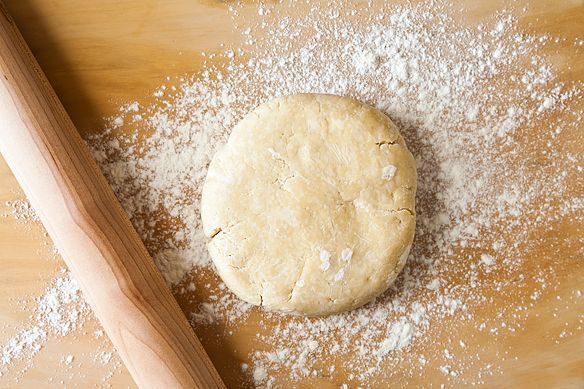Popular on Food52
15 Comments
phip
May 29, 2022
What I like most about the comment section is that it reminds me of the direction signs with arrows pointing in different directions to the same destination. My scalp begins to itch. Amanda did you say "without loosing your cool" LOL
breadwhisperer
October 16, 2015
1. Parchment paper works better than plastic wrap. Flip the "sandwich" over half way through to make sure both layers are well-floured and not getting stuck. I use a pastry brush to remove extra flour before transferring dough to pie plate. 2. To the commenter asking about pastry cracks: that indicates that the butter/fat in the dough has not been adequately incorporated into the flour. When cutting in the butter, I find it more helpful to focus on the change in the flour texture. Don't stop until the flour has lost it's powdery texture and has changed color from white to cream. (Don't worry about the butter - it you've kept everything cold, there will still be nice blobs of butter in there.) If you coat all the flour with fat, you will need less water to make the dough, and you will have less cracking when you roll it out.
Hannah K.
November 14, 2013
My biggest problem rolling out pastry crust would be the cracks, which turns into the dough splitting...any suggestions?
FischFood
October 31, 2013
Ok.. you might call me a pastry wimp, but in all honesty, I recently discovered a miracle worker for rolling out pie dough et all. It's called "Mrs. Anderson's Baking Pie Crust bag 14" (for 11" and 12" pies)". It's like a duvet for dough! Simply sprinkle the dough with a little flour, put it in the RoundPie Crust Bag, zip it up to close and roll out to the desired diameter. Unzip and your pie crust is ready to be transferred to the pan, with virtually no mess and little clean up!
Lisa P.
December 16, 2012
A moist, supple dough solves a multitude of problems. I use the amount of water called for in recipe then add a couple tablespoons of vodka kept on freezer for just this purpose. It evaporates at a lower temperature than water, allows you to roll with ease and leaves you with a flaky, tender crust. Lightly dust the board and pin and give a quarter turn after each pass and you're there. The addition of vodka has eliminated the need for parchment or plastic. Learned this from Americas Test Kitchen.
Hannah K.
November 14, 2013
you are adding a couple (say 2) of tablespoons of (frozen) vodka to the dough, in addition to how much water (usually a 1/4 cup)?
Alexis S.
November 21, 2012
My edges are never that neat--what's the secret to that perfectly round, unbroken edge?
JaniceB
November 14, 2012
I've been using parchment paper--for me, it's easier to work with than the plastic wrap and achieves the same effect.
Oui, C.
May 8, 2012
I want to kiss you for this....just brilliant! Can't wait to cook my next tart to try out this technique.
The Y.
May 8, 2012
Instead of struggling with plastic wrap, you will have more success if you use a pastry cloth and rolling pin cover. They're usually sold as a set. Wash it before your first use, it makes it softer. "Season" the cloth by sprinkling a lot of flour on the cloth and stocking cover and work it into the cloth with your hands until it won't hold anymore flour then brush off any excess. This makes the cloth non-stick but it won't make your dough tough. You need to sprinkle on a little more as you work. Keep moving your pastry around to make sure it isn't sticking. Hold your pie plate above the dough and when it is about 2" wider than your pan, gently lay your rolling pin on the dough and lift the pastry cloth to wrap the dough around your pin. Then gently unroll the dough into your pan. If your dough wants to crack when you're rolling and handling it, it is either too cold or too dry. You don't want the dough to be really wet, but it has to be moist enough to form a good solid ball or it will fall apart. And it doesn't need to chill more than 20 minutes or so, depending on your room temperature. Especially if you are using all or mostly butter it will be too firm to roll if you chill it too long. Feel the dough, it needs to be pliable. When you're finished, shake out the pastry cloth or scrap off any bits of dough that are stuck on and store it in a plastic bag. Lightly re-flour it with each use. Don't wash it until it begins to absorb fat and will no longer prevent sticking. Every time you wash it you have to "season" it again. Personally I prefer a dough made mostly with Crisco plus a couple of tablespoons of butter for flavor. It makes a much flakier crust than all butter. I've been baking pies for more than 40 years and using a pastry cloth is the only way to go. Of course practice makes perfect, but once you get used to using a pastry cloth you'll never use plastic again. It's also the easiest way to roll out cookies.
GoodFoodie
May 6, 2012
My confusion arises from not knowing how long to wait after I have chilled it in the frig?? When I take it out, it's a hard rock. How long do I wait before starting to roll? Never have good luck.....
devendra
May 6, 2012
If you are using a baking pan with a removable bottom, try placing it under the dough before rolling and roll it out over the dough. You can see the edge of the disc under the dough so it's easy to judge when the dough is rolled out large enough. To transfer the whole thing to the pan rim, just fold the edges of the dough over the center, then lift the whole thing by the edges of the pan disc and unfold in the ring.
abbyarnold
May 6, 2012
I need help dealing with the plastic wrap...it always bunches up on me, and it is never wide enough. I bought a great gadget at Bed Bath & Beyond that is a round zippered plastic thing that you put your dough in and roll out, then unzip. Perfect! But would love some help on the two challenges to plastic wrap: (1) not wide enough, and (2) smooshes up and sticks to itself.
emf224
May 7, 2012
I have the same (frustrating) issues with plastic wrap. The wrap in the video looks very different than what I use: it looks thicker and less clingy. I wonder, is it some kind of professional-grade/industrial strength product?
LucyLean
May 6, 2012
Thanks for sharing this - I always use plastic wrap for rolling out dough - I also like to place the rolled out dough back in the refrigerator for about 10 mins once I have rolled it out before transferring to the pie or tart pan. Nothing like pie making


See what other Food52 readers are saying.